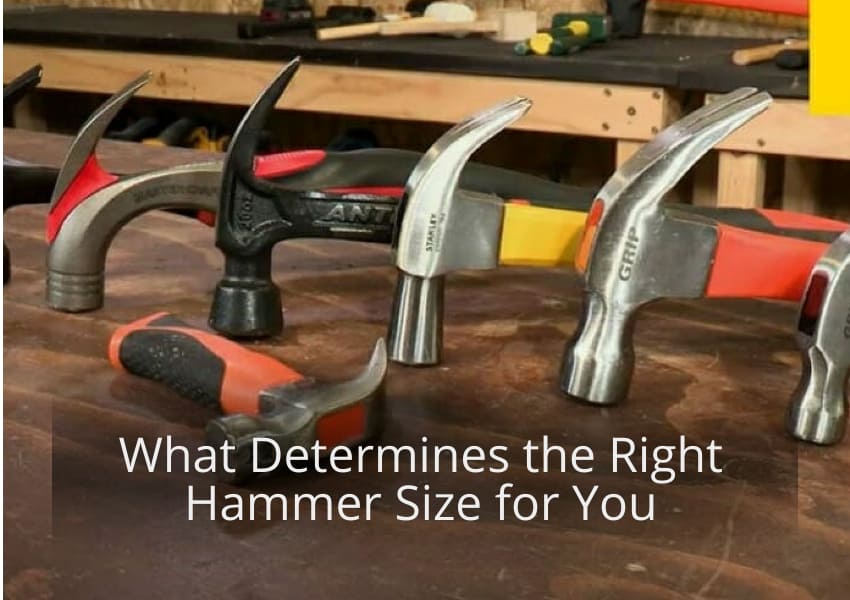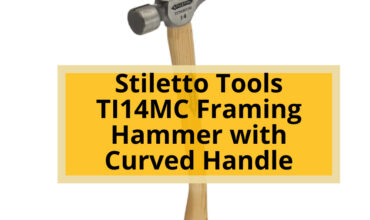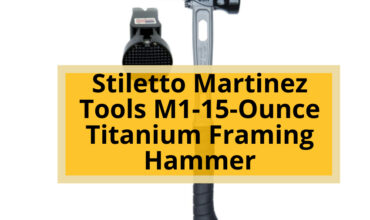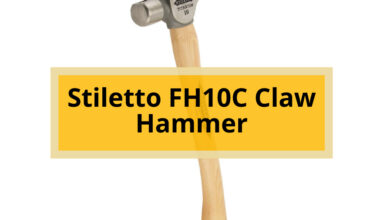You might be thinking, ‘Why does the size even matter?’ Using the correct hammer size for your project can make all the difference.
So, let’s dive in and discover the perfect fit for all your hammering needs!
What Determines the Right Hammer Size for You?

When determining the right hammer size for you, there are a few key factors to consider.
· Head Size
· Hammer Total Weight
· Your Arm Strength
Moreover, always keep in mind your level of professionalism, type of work you need the hammer for and how often you are going to use it.
Hammer Head Size
To determine the size of hammer head you need, take into account the type of project you’re working on. The size of the hammer head is crucial for achieving optimal results.
For smaller, delicate projects such as assembling furniture or hanging picture frames, a lighter hammer head with a smaller striking surface will suffice. This allows for better precision and control.
On the other hand, for heavier duty projects like construction or demolition work, a larger hammer head with a wider striking surface is recommended. This will provide more force and impact to effectively drive nails or break through materials.
Hammer Total Weight
If you’re looking for a lighter tool, consider opting for a hammer with a lower total weight. The total weight of a hammer is an important factor to consider when choosing the right tool for your needs.
A lighter hammer can be easier to handle and maneuver, reducing fatigue and strain on your arm muscles. It is especially beneficial if you are working on projects that require repetitive hammering or if you have limited strength or mobility.
However, keep in mind that a lighter hammer may not be as effective in driving nails into harder materials. It is important to strike a balance between weight and power, choosing a hammer that is suitable for the tasks you have in mind.
Your Arm Strength
Having limited arm strength may make it difficult for you to handle a heavy tool. When it comes to choosing the right size hammer, it’s important to consider your own physical abilities.
If you have weaker arm muscles or limited mobility, opting for a lighter hammer can make your tasks easier and more efficient. A lighter hammer will require less effort and strain on your arm, allowing you to work comfortably for longer periods of time.
It’s essential to choose a hammer that you can confidently grip and control, ensuring safety and accuracy in your work. Remember, the goal is not to impress others with the size of your hammer, but rather to find a tool that suits your abilities and allows you to accomplish your tasks effectively.
Are You a Professional or A DIY?
When it comes to choosing the right size hammer, it’s important to consider your level of expertise and the tasks you’ll be undertaking.
If you’re a professional, you likely have experience in various construction or carpentry projects, and a range of hammers in your toolbox.
For DIY enthusiasts, it’s essential to have a basic understanding of the different hammer sizes and their uses.
A 16-ounce claw hammer is a versatile choice for most household projects, such as hanging pictures or assembling furniture.
However, for more heavy-duty tasks like framing or demolition, a 20-ounce framing hammer would be more suitable.
Type Of Work the Hammer Is Used For
When using a hammer, consider the type of work you’ll be doing and choose the appropriate tool. It is crucial to select the right hammer for the job at hand in order to achieve optimal results and ensure your safety. Different types of hammers are designed for specific tasks, so it’s essential to understand their purpose and choose accordingly.
For lighter tasks such as hanging pictures or assembling furniture, a small claw hammer with a wooden or fiberglass handle would be suitable. These hammers are lightweight and easy to handle, providing the necessary precision for delicate work.
If you’re dealing with heavier tasks like driving nails into hardwood or breaking through concrete, a larger framing hammer or a sledgehammer would be more appropriate. These hammers have longer handles and heavier heads, allowing for greater force and impact.
How Often You’ll Need This Tool?
Now that you know the type of work the hammer is used for, let’s consider how often you’ll need this tool.
Understanding the frequency of your hammer usage is crucial in determining the size you need.
If you’re someone who frequently undertakes DIY projects or engages in construction work, a larger and more robust hammer may be ideal. This will ensure durability and efficiency in handling heavy-duty tasks on a regular basis.
On the other hand, if you only require a hammer occasionally for small repairs or light tasks around the house, a smaller and more compact hammer would suffice.
Frequently Asked Questions
Can I Use a Larger Hammer for Smaller Tasks?
Yes, you can use a larger hammer for smaller tasks, but it may not be as effective or precise. It’s best to use a hammer that is appropriate for the size and nature of the task at hand.
Can I Use a Smaller Hammer for Heavier Tasks?
Sure, you could use a smaller hammer for heavier tasks, if you want to make it harder on yourself and risk damaging the tool or your work. But hey, it’s your call
Are There Any Safety Precautions to Consider While Using Hammers?
When using hammers, it’s important to take safety precautions. Always wear protective eyewear and gloves. Make sure you have a firm grip on the handle and use the appropriate size hammer for the task at hand.
How Can I Ensure the Longevity of My Hammer?
To ensure your hammer lasts, keep it clean and dry after use. Store it in a cool, dry place to prevent rust. Regularly inspect the handle and head for any signs of wear or damage.
Can I Use a Hammer on Any Type of Material?
Yes, you can use a hammer on various materials. However, it’s important to choose the right size and type of hammer for each material to ensure effective and safe results.
Conclusion
So there you have it, the key factors to consider when determining the right hammer size for your needs. Remember, ‘measure twice, cut once.’
By understanding the type of work you’ll be doing, the materials you’ll be working with, and taking into account your own physical strength and comfort, you can confidently choose the perfect hammer size.
Don’t underestimate the importance of selecting the right tool for the job – it can make all the difference in the world.
Happy hammering .






